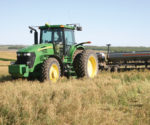Advertise Follow Us
Articles Tagged with ''University of illinois''
Keep Yields From Cooling Off
Cover crops can offset the major causes of yield drag in fields making the transition to no-till and improve the soil biology of fields lacking crop and residue diversity
Read More
What I've Learned from No-Tilling
No-Till Proving Not To Be a 'Drain' For Illinois Grower
Long-time no-tiller Doug Harford was among the earliest pioneering conservation farmers to break ground on drainage, yield mapping, grid soil sampling and strip-till
Read More
Cover Crops Make Long-Term No-Till Perform Even Better
Iowa no-tiller drills cereal rye as soon as possible after harvesting corn and soybeans for maximum growth and better soil structure
Read More
Get Your No-Till Soils To Feed Your Crops Nitrogen
University of Illinois fertility specialist Richard Mulvaney says the soil can be much more important to supplying nitrogen to no-tilled crops than fertilizer nitrogen
Read More








